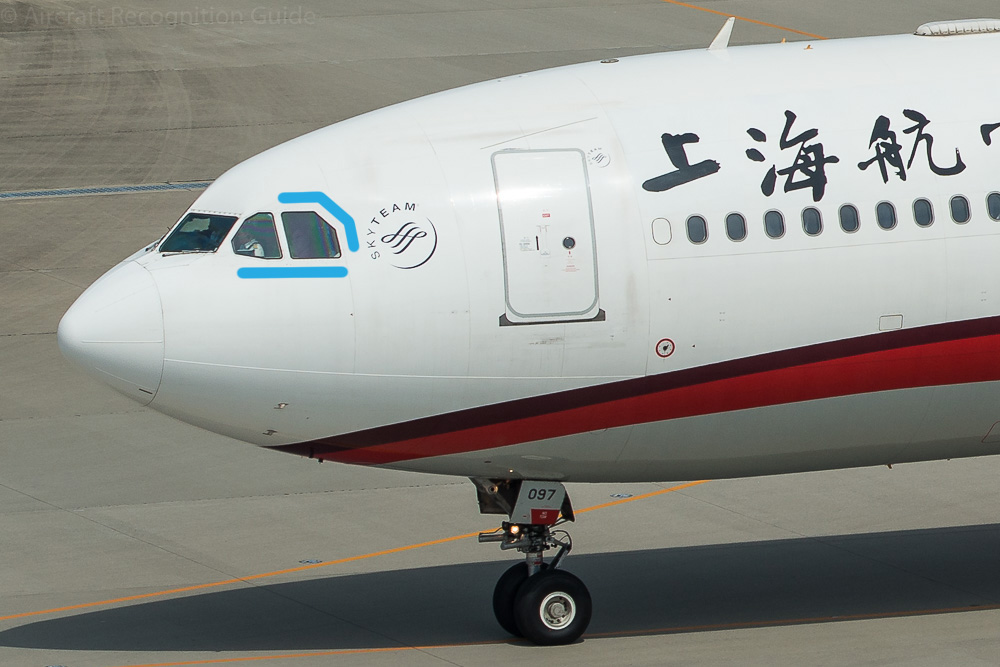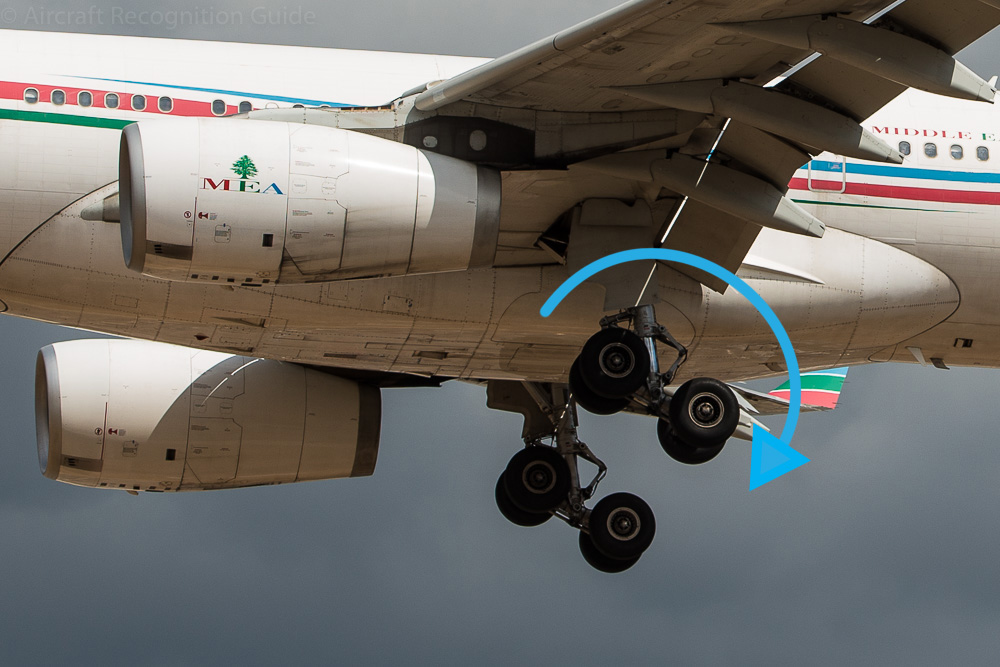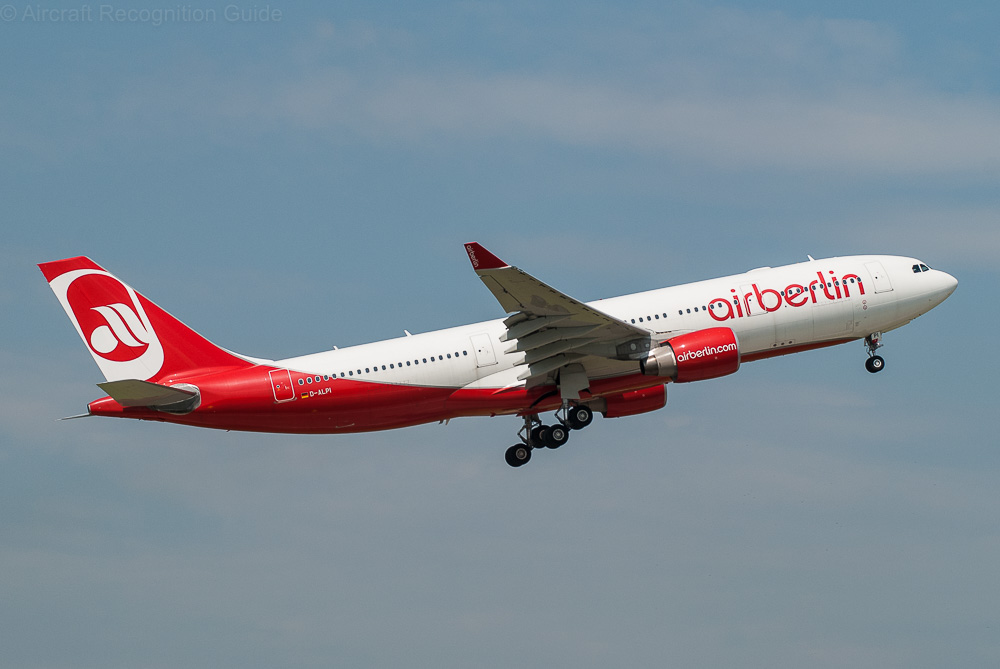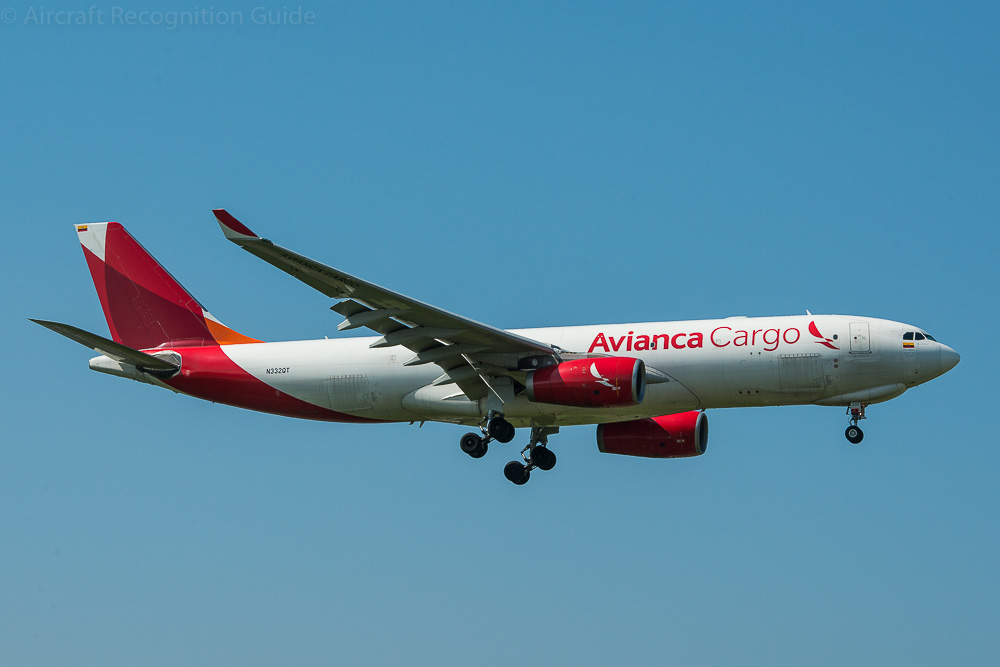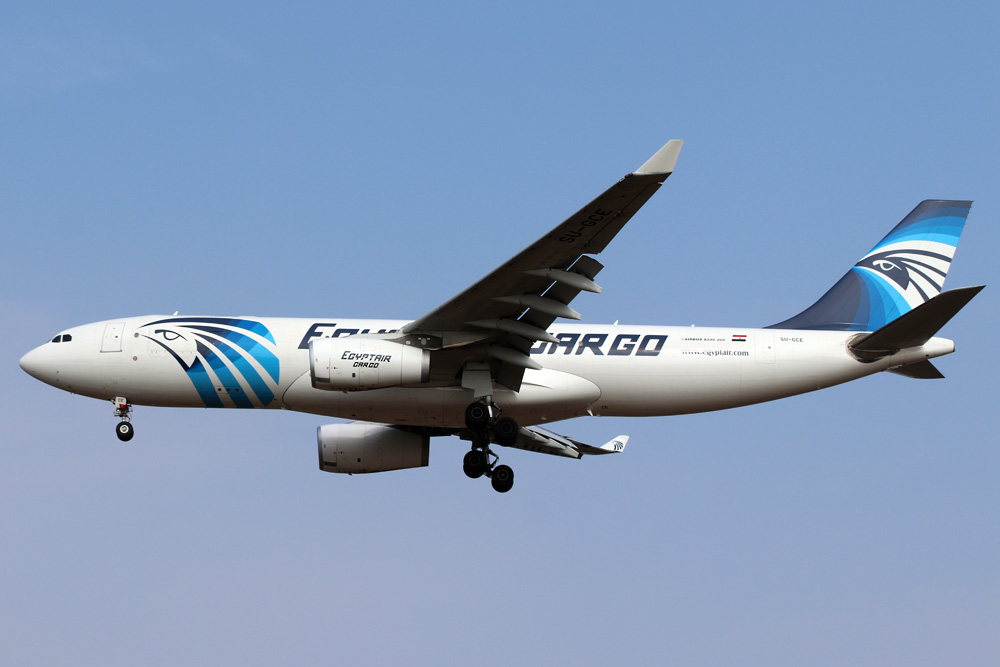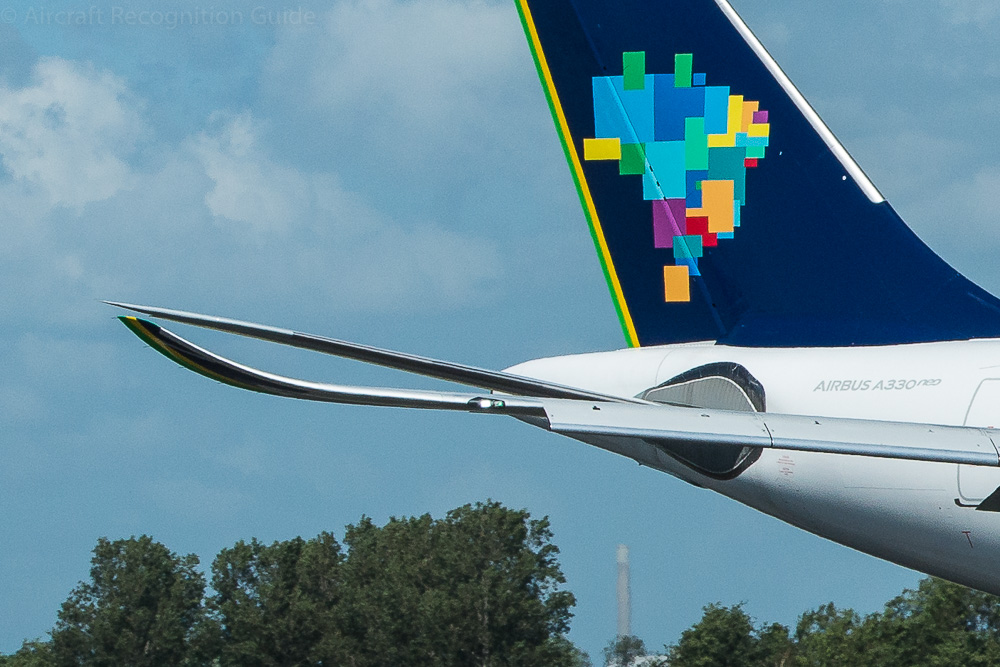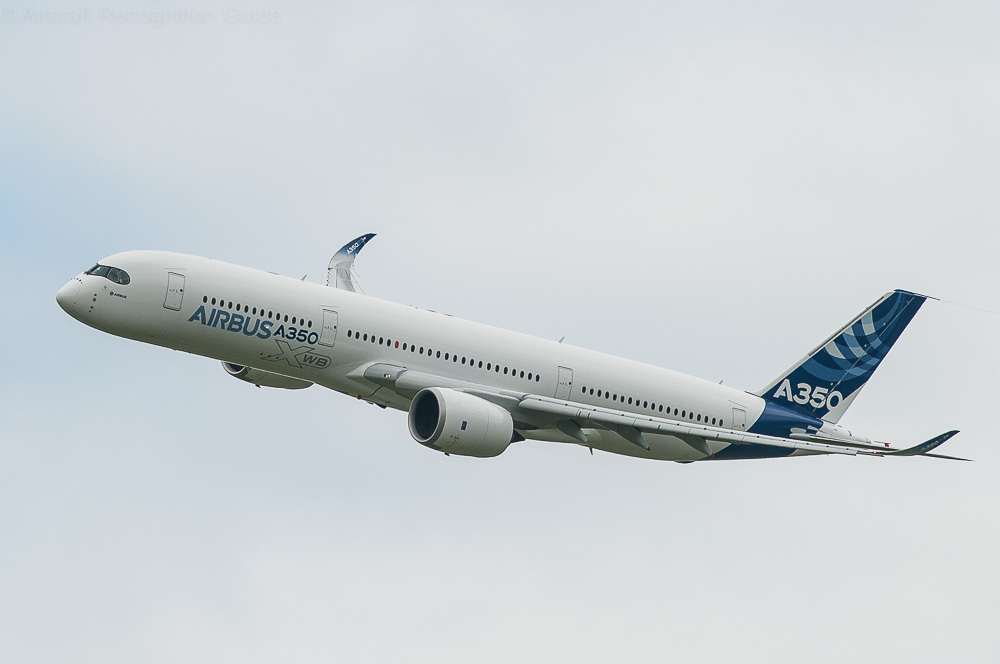
Airbus A330
The second generation Airbus wide body aircraft is clearly a derivative of the A300: the general appearance is the same. This includes the typical last cockpit window with the cut-off top corner. Furthermore, the row of cabin windows on the rear fuselage, towards the tail cone, appears to be curved up compared to the rest of windows. Also the tail section looks identical. These are at the same time the main recognition points to distinguish the aircraft from the Boeing 767 and 777, and to a lesser extend the Airbus A350. The most notable changes on the A330 compared to the A300 are the winglets and the backward tilted main landing gear bogeys (when the aircraft is airborne).
All Airbus wide bodies before the A350, thus also the A330, have the same nose with a cut-off top corner of the last cockpit window.
The main gear has four wheels on each leg. The bogeys are titled backward when there is no weight on the wheels. Also note the Rolls Royce nacelles with single exhaust.
The tail section of Airbus A330 (and A300, A310 and A340), with the last row of cabin windows appearing to slope up slightly.
Different versions
The different versions of the Airbus A330 can be distinguished by the following features:
- the length of the fuselage
- the shape of the engine nacelles
- the shape of the winglets
- the presence of a bulge under the forward fuselage
- the presence of a tank boom under the rear fuselage
- the diameter of the fuselage
Airbus A330-200 & ACJ330
The A330-200 is the shortest of the original two main variants. While it has a higher vertical stabiliser than the A330-300, this is not clearly visible. The five metre difference in length is better visible. If you are still not sure, then counting windows between main cabin doors is the only option left.
For the A330-200 you have a choice of three engine manufacturers: Rolls Royce with mixed exhaust nacelles (see photo above), Pratt & Whitney with separate fan exhaust and General Electric, which engine has a cone in the back.
Airbus offers a corporate jetliner version of the A330-200, known as the ACJ330 or A330-200 Prestige.
Airbus A330-200F
The dedicated cargo version is clearly distinguishable from both the passenger version and converted passenger aircraft. The first recognition point is of course the lack of cabin windows (or painted over metal plugs). The A330-200F also has a bulge under the forward fuselage. This is a fairing for the modified nose gear, allowing the aircraft to be more level when on the ground.
Airbus A330-200P2F
A330-200s can be converted to cargo aircraft, designated A330-200P2F (passenger-to-freighter). Like the dedicated cargo version the cabin windows are not visible (being painted over). The A330-200P2F however has no fairing under the forward fuselage.
A converted passenger Airbus A330-200 has metal plugs in place of the cabin windows and no fairing under the forward fuselage. (photo: Joschi71/WikiMedia)
Airbus A330-300
This was the first version of the A330. It is about five metres longer than the A330-200. The best way to recognise it is by the length. If that is not obvious enough, than look at the number of cabin windows. This is done easiest between the first two cabin doors. For the rest the versions are the same and have similar engine options.
The Airbus A330-300 has more cabin windows than the A330-200, because it is five metres longer.
Airbus A330-300P2F
The A330-300 can also be converted to cargo aircraft. This A330-300P2F has its cabin windows replace by metal plugs and has no bulge under the forward fuselage. And naturally it is longer than the A330-200P2F.
An Airbus A330-300P2F, recognised by the lack of cabin windows, long fuselage and no bulge near the nose gear.
Airbus A330-700L Beluga XL
As Airbus needed a larger aircraft than the A300 Beluga to transport more A350 wings, it converted the A330-200 with a much larger diameter fuselage, a lowered cockpit, a big dorsal fin and additional vertical stabilisation surfaces at the end of the horizontal stabilisers. This makes it look like the Beluga, but of course the bigger winglets allow you to distinguish them.
The A330 Beluga XL is similar in appearance as the A300 based Beluga, but has the A330 winglets as recognition point. (photo Dylan Agbagni/WikiMedia)
Airbus A330-800
With the Airbus A350 having evolved more in a Boeing 777 competitor than a 787 competitor, the latter was countered with an updated version of the A330. Even though this is called A330neo (of new engine option), there are more changes. The aircraft also has new wings with curved winglets. The engines have a larger diameter than the previous ones. They have a cone in the core exhaust like the General Electric CF6 engines, but the exhaust part is small compared to the rest of the nacelle. Finally most neos have a "zorro mask" painted around the cockpit windows, but this can be done on older models as well, of course.
The A330-800 is the shortest version of the A330neo, comparable to the A330-200.
The A330neo engine has a core cone like the General Electric engines of the original A330s. However, they have a larger diameter and a shorter exhaust.
Airbus A330-900
The long version of the A330neo is the A330-900. Except for the length there are no external differences with the A330-800.
An A330-900 of Azul Airlines.
Airbus A330MRTT
Based on the A330-200 Airbus developed a military transport and aerial refuelling version, called A330MRTT (Multi-Role Tanker Transport). It is recognisable by pods under the wings and/or a tank boom under the rear fuselage; not all versions are the same.
The aircraft is designated KC-30A in Australian service, Phénix in France, KC-330 Sygnus by the South Korean air force and Voyager by the Royal Air Force. The aircraft was entered in the USAF competion as KC-45A, which it lost to the Boeing KC-46A.
Confusion possible with
Airbus A300
The Airbus A300, A310 and A330 look very similar with their characteristic cockpit windows, the row of cabin windows on the rear fuselage appearing to be curved up compared to the rest of windows and the tail section. The way to distinguish the A300 is by the non existent or very small winglets and straight main landing gear bogeys.
Airbus A350
Compared to the Airbus A330 (and A300) the A350 has a different style of cockpit windows in a re-contoured nose, an even smaller dorsal fin and winglets curling up from the wing tip. Also the last row of cabin windows is straight.
Boeing 767
The Boeing 767 is the direct competitor of the Airbus A330 in size and performance. The main recognition points of the 767 compared to the Airbus are the cockpit windows and titled forward main landing gear bogeys, but also the winglets (if present).
Airbus A340
The A330 and A340 are externally very similar except for one big difference: the A330 has two engines while the A340 has four!

